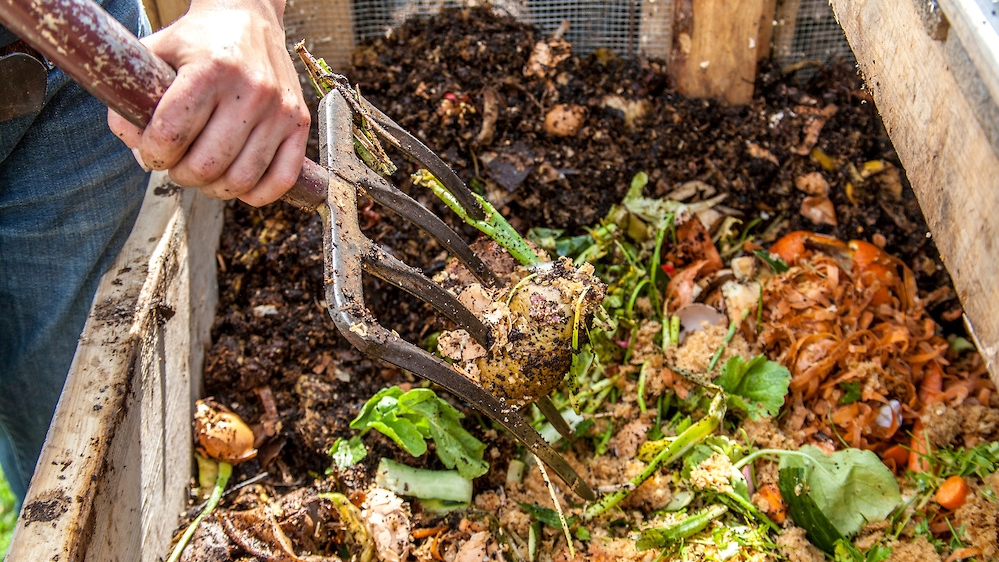 Pillar: Reverence
Pillar: Reverence
Laudato Si’ Action Plan Goals: Response to the Cry of the Earth, Ecological Spirituality, Community Engagement and Participatory Action
 Pillar: Reverence
Pillar: Reverence
Laudato Si’ Action Plan Goals: Response to the Cry of the Earth, Ecological Spirituality, Community Engagement and Participatory Action
Group (Grade Levels): 8 years old to adult
Learning Goals:
- Learn how to maintain a compost pile
- Ponder and learn to reverence how what is “rejected” can become useful and nourishing
Materials Needed: active compost pile, leftover food such as apple cores, citrus peels, banana peels, vegetables, etc; leaves, grass clippings, worms, shovels, work gloves
Estimated Time to Complete Activity: 1 hour
Estimated Number of Sessions if Activity Continues: unlimited as you continue composting!
General Outline of Experience
Scripture passage and suggested introductory questions
- “In the sweat of your face you shall eat bread till you return to the ground, for out of it you were taken; you are dust, and to dust you shall return” (Genesis 3:19).
- Read the following quote from the essay “Theology of Garbage” by Fr. Raymond Ellis: “Egg shells are nothing other than eggs which have given their all on behalf of man. Garbage is a sign that other creatures of God have died that man might live more abundantly. Coffee grounds, bones, empty bottles, orange peelings, apple cores, watermelon rinds…they all tell the same story: Death, self-gift, emptying oneself on behalf of others. A religious person will never be far from Christ or the meaning of his life and death when he is busy with garbage…”
- How do you normally think about garbage?
- How does Fr. Ellis think about it? Is his view new to you?
Concrete opening experience:
- Go out, collect compost soil and see what it looks like; describe it.
- Look in the leftover food container and describe its elements.
- How does the food become this beautiful soil?
- Short explanation of how the food decomposes and how, as humans, we can facilitate and benefit from that process.
- Go to the compost pile with the group and explain the reason for its location and how it was built.
- Review how to use a shovel safely and how to set it down safely.
- Divide the group into two groups. One will work on integrating food while the other will carry fully cooked compost soil to a desired location.
- Show the students how to open the pile and integrate the food, chopping it for better integration.
- Add grass clippings for heat, explaining how the heat breaks down food.
- Put leaves on top to keep heat in.
- Proposed discussion:
- Ask the students what was most fun about the experience. What was most surprising?
- What are some things we have that may be considered “garbage”? Can those things be put to good use?
- Ask the students what they can do at home and think of one person that they can teach what they learned today too.
- Read the following quotation from Laudato Si’, n. 22 and discuss as a closing: “[Many] problems are closely linked to a throwaway culture which affects the excluded just as it quickly reduces things to rubbish. To cite one example, most of the paper we produce is thrown away and not recycled. It is hard for us to accept that the way natural ecosystems work is exemplary: plants synthesize nutrients which feed herbivores; these in turn become food for carnivores, which produce significant quantities of organic waste which give rise to new generations of plants.”
- Potential analogies
- Unwanted food is like our faults and foibles that we would rather hide but can become part of the “good soil” with some work.
- What is the composting process that is going on inside yourself at this time? Where is your “good soil” and what still needs to be worked on? How can you go about working on the un-composted parts of yourself?
- Can you apply this to how you love other people, even with all their faults and foibles?
For adults, consider pondering the analogy between Mary and soil/earth, which the Fathers of the Church emphasized
- “Should I compare you, Mary, to the fertile earth and its fruits? You surpass them, for it is written: ‘The earth is my footstool.’ (Is 66:1). But you carry within you the feet, the head, and the entire body of the perfect God” (Athanasius, Homily of the Papyrus of Turin; quoted in Mary and the Fathers of the Church, by Luigi Gambero, pg. 106).
- “Just as their very bodies have sinned and die, and as the earth, their mother, is cursed, so because of this body which is the incorruptible Church, His earth is blessed from the beginning. This earth is Mary’s body, the temple in which a seed has been deposited” (Ephrem the Syrian (306-373 AD) Diatessaron 4, 15: quoted in Mary and the Fathers of the Church, by Luigi Gambero, pg. 114).
Cross-references to related experiential activities: Cooking Together, Garden Work – 4 Stages, Gardening as Community Service




